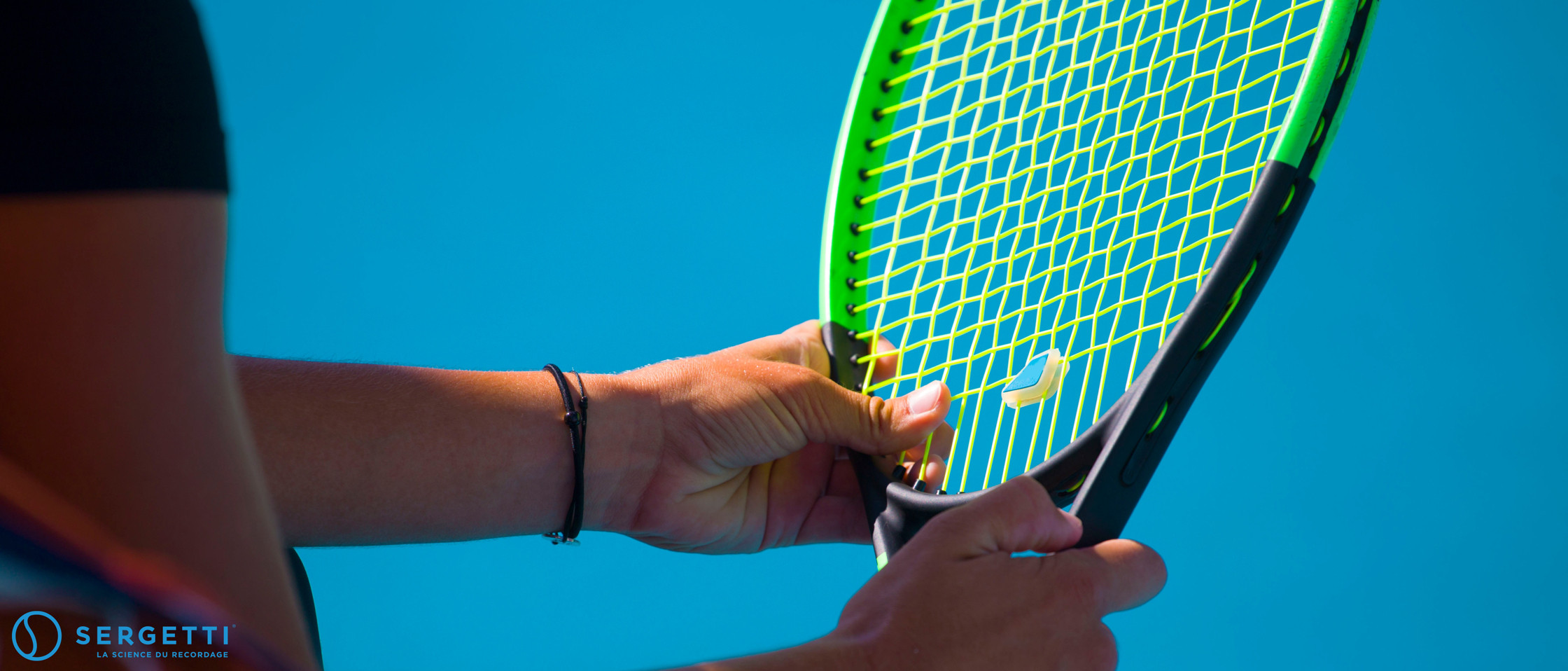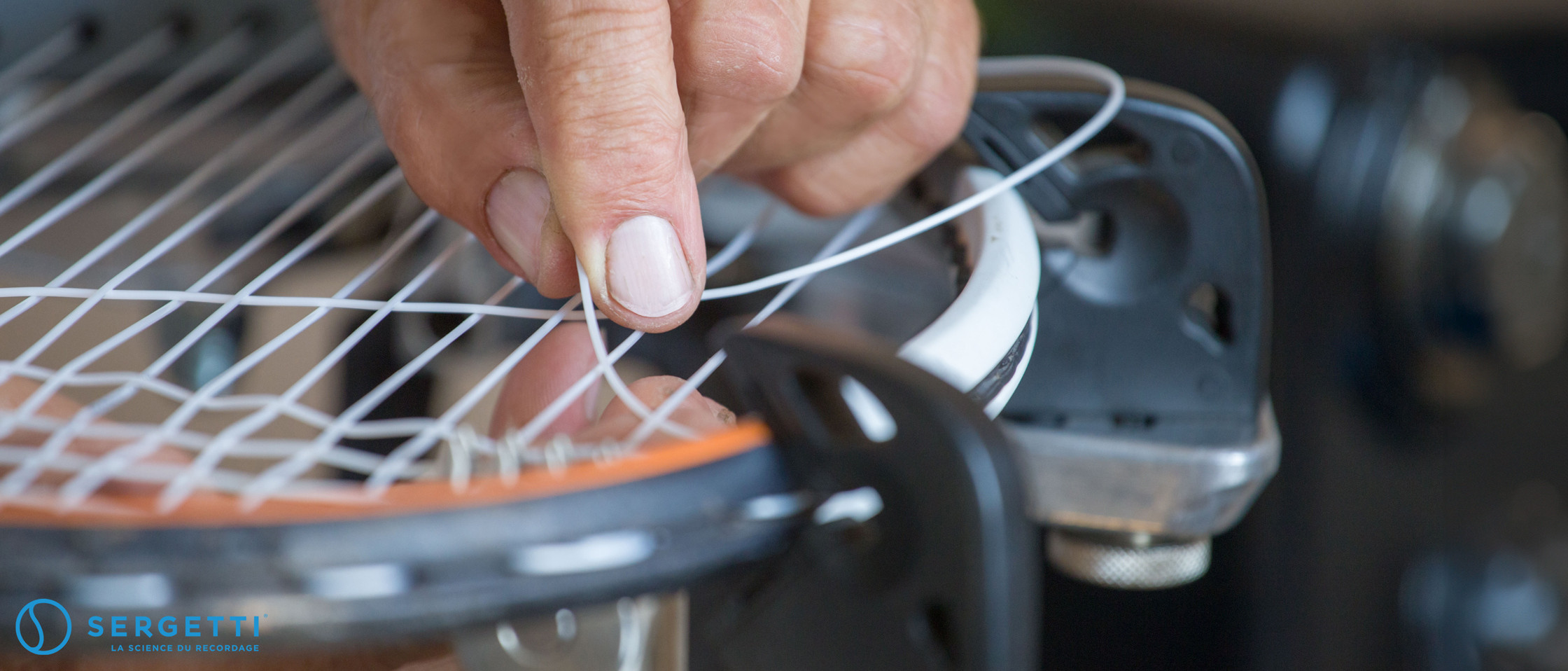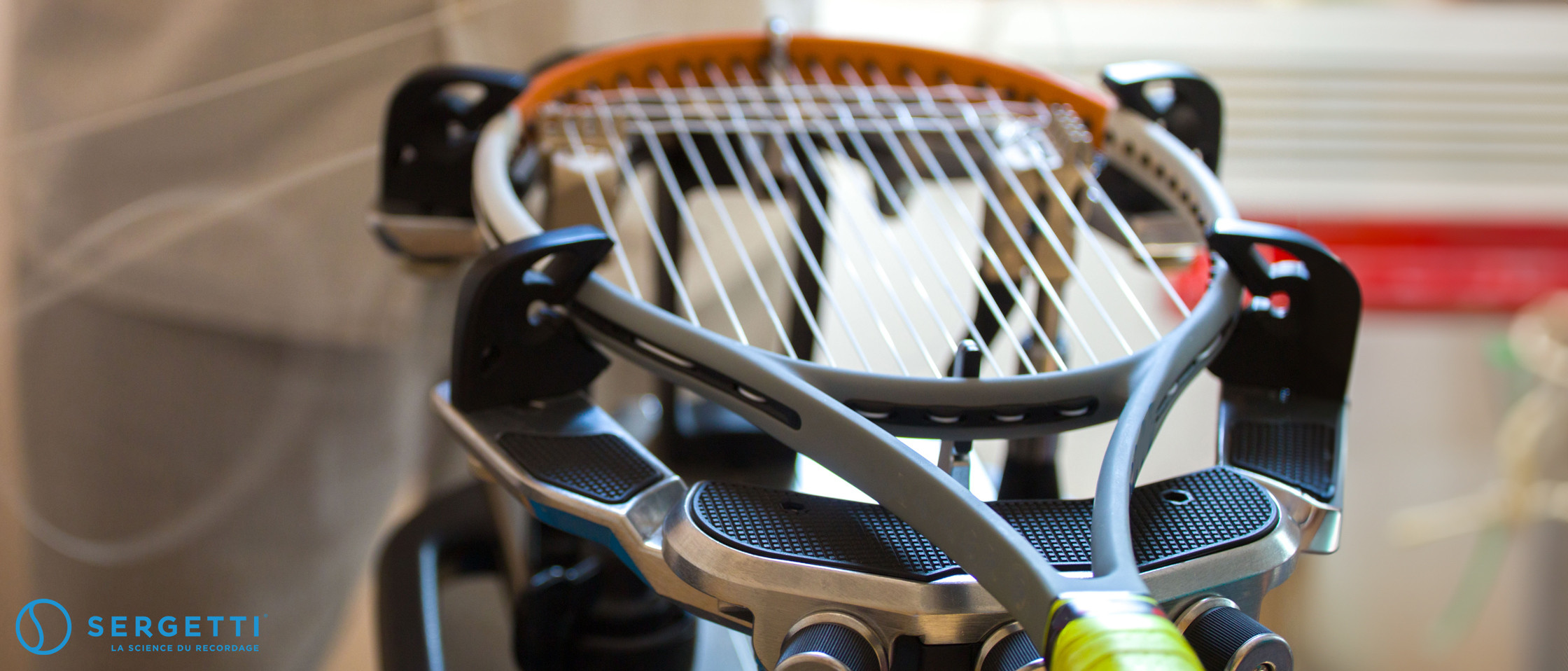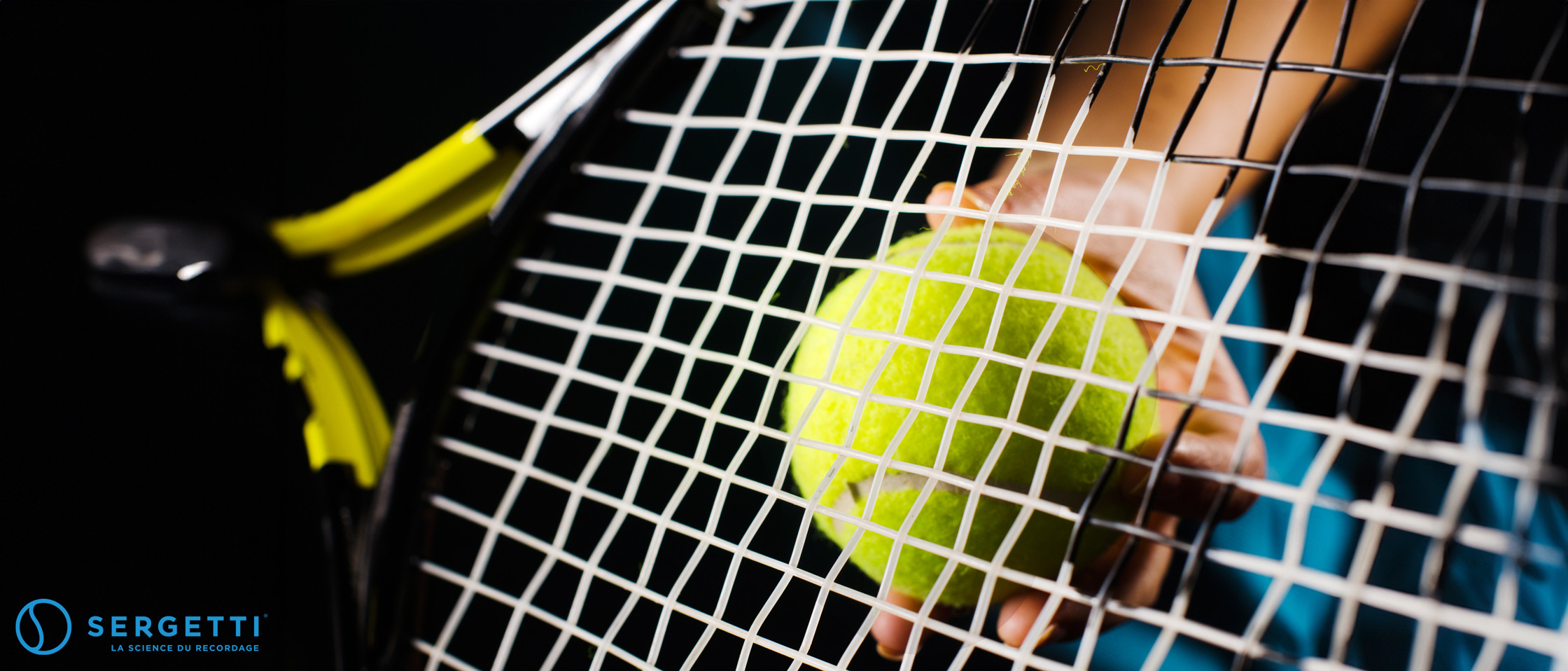A completely personal choice
The choice of tension is very important to obtain the balance between power and control in your shots. Too much or too little power leads to a decrease in control.
The choice of tension is also directly linked to the choice of string material and the type of installation, which are both very important to suit your specific preferences and needs.
In addition, the stringing process (discussed later) is the essential element to obtain optimal performance and comfort from your tennis racket and string(s).
The preferred tension for a player can be very different from one player to another and regardless of the level of play and power of each player.
The following different factors are mainly those that make a player prefer one tension over another:
- A less adequate hitting technique
- More or less accentuated wrist whip
- Racket head speed/power
- The hitting angle for SPIN (ball rotation) or flat (without ball rotation)
- The perception of the sound produced by the impact of the ball on the string
It is therefore easy to understand that all these aspects described above are not all the same for everyone, which therefore makes the tension preference a totally personal choice.
A good starting point for choosing a tension
A good starting point for choosing a tension is to be able to provide the stringer with some reference information, such as what tennis racket model, string(s), and tension you are currently using.
If you are a beginner and are considering purchasing your first tennis racket, having a reference to provide to your stringer could be done by having the opportunity to try out a racket from a friend who knows the Brand and Model of his racket, the string(s) used, and its tension to provide to the stringer, this would be ideal. Another option would be to try out a demo tennis racket from a store.
From this reference information, the stringer will ask you relevant questions about your experience with your equipment to determine what would seem to be the best tension and string type for your specific needs.
If you don’t have any reference, you must start somewhere and the stringer will suggest a type of string(s) and tension for your tennis racket model, and then gather your impressions once you have played a few times, then suggest adjustments if necessary for the next restringing.
Understanding power and control
It is important to have a tension that results in a balance between power and control, therefore controllable power.
If you have too much or not enough power, it will result in a lack of control of your shots.
We can refer the aspects of power and control from the ball distance that you obtain in the majority of your shots with your usual swing.
If you tend to hit balls longer than desired and you constantly must hold your swing to shorten your ball distances, we can consider that there is too much power.
On the other hand, if your shots result in balls that are too short and you must force to have the desired ball distance, we therefore consider a lack of power.
Choose the tension
If you want to increase the power to increase the desired distance of your balls, you must REDUCE the tension. Therefore, a slightly more trampoline effect of the string.
Conversely, if you want to reduce the power to reduce the distance of your balls, you must INCREASE the tension, and consequently, the control of the strikes and ball distances will be improved.
To give you an idea, some professional players use a tension as low as 23 lb (10.4kg) while others use 70lb (31.7kg). The most used tensions with Polyester string(s) for example are between 45 and 55 lb approximately.
Testing different tensions can guide you towards your ideal tension allowing you an easily controllable power.
Power VS ball speed
However, do not believe that a tennis racket strung at an extremely low tension of 23lb (10.4kg) will be extremely powerful, and that one strung at 70lb (31.7kg) will have no power.
When we talk about power from the beginning, we are referring to the ball distance and not the ball speed.
For the same force and hitting angle, the tighter string will result in shorter balls than a looser string, therefore less distance. Hence the reference of less power.
As for the speed of the ball coming out of the string, it depends almost exclusively on the hitting speed of the tennis racket and very little on the type of string and its tension.
Strings / materials
The choice of tension is also a consequence of the choice of the material of the string used since the materials used can be very soft to very stiff, thus resulting in different responses from them.
To help facilitate the distinction between very stiff and very soft strings, we have categorized them from (1) to (5), of which Category (1) is the stiffest material (less elastic) and (5) the softest (more elastic).
The category in parentheses will be written at the end of each type of string for the following.
Here are the main choices of material from the stiffest to the softest:
- Kevlar (which is almost no longer used) – Category (1)
- STIFF Polyester – Category (2)
- SOFT Polyester – Category (3)
- VERY SOFT Polyester – Category (4)
- Nylon (Synthetic Gut & Multifilament), Natural Gut (Nat Gut) – Categories (4) and (5)
For example, for the same model of racket strung with a soft Nylon (5) at 60lb, the equivalent tension with the use of a stiff Polyester (2) will be 54lb. So, a reduction of 10%.
As shown above, there are different stiffnesses of Polyesters, from stiff (2) to very soft (4), and therefore different choices of tensions according to the stiffness as follows:
- Reference tension Stiff Polyester (2): 50lb (22.7kg)
- Tension with range of soft Polyesters (3): 51-52.5lb (23.1-23.8kg)
- Tension with range of very soft Polyesters (4): 53-54.5lb (24-24.7kg)
It should be noted that in each category, there is a range of tensions since there is a range of stiffness/softness in each Category.
Types of string installation
There are 3 variations of string installation where the choice of tension will vary:
- Same string in both directions, vertical (MAIN) and horizontal (CROSS)
- Hybrid (2 different strings): The most durable/stiff string in the vertical strings (ex: Polyester, Kevlar), and the most flexible in the horizontal strings (ex: Nylon, Multifilament, Natural Gut or a Polyester more flexible than the vertical strings.
- Reverse Hybrid (2 different strings): The most flexible string in the vertical string (ex: Nylon, Multifilament, Natural Gut or a Polyester more flexible than the horizontal strings), and the most durable/stiff in the horizontal strings (ex: A Polyester more flexible than the vertical string).
Spin potential
What type of string(s) and setup offers the best spin potential?
We are talking about spin potential here because it is important to specify that a player with a flat swing, which is therefore not from the bottom to the top for a topspin effect, will not obtain more spin even if he uses a string and setup with the optimal potential for spin.
Types of strings for spin
The type of string offering the highest spin potential is Polyester (2)(3), and this, in the vertical (MAIN) and horizontal (CROSS) strings, and whose friction coefficient is very low, therefore more slippery.
So, what offers this great potential for effects is the fact that upon impact of the ball, it will grip the vertical string which will slide and move on the horizontal string, and with the tension of the vertical string, it therefore makes a sudden return to its original position, an effect called SNAP BACK on the ball, therefore an additional rotation push to the ball.
From this explanation, we can understand that the optimal potential for effects would be with a vertical Polyester string with a low friction coefficient and a shape that allows the ball to be well gripped (high ball on string friction).
This is the reason why Polyester string manufacturers make strings in square, triangular, pentagonal, hexagonal or octagonal shapes.
To optimize the potential of the spin effect, the horizontal string must of course be a Polyester (2)(3) and of a very low coefficient of friction as well, in addition to having the smallest possible contact surface with the vertical string, thus allowing a minimum of friction between the 2 strings to obtain a better glide of the vertical string and SNAP BACK effect.
The ideal would therefore be a round string. Of course, strings as described above with 3 to 8 faces can do very well since we are talking about strings between 1.10 mm to 1.41mm, and the most popular between 1.23-1.30mm, where we can barely or not feel the faces to the touch.
We remind you that a swing favoring the rotation of the ball is necessary to solicit the spin potential of the string.
Types of Stringing for SPIN
Here are the types of spin potential (SPIN) installations from highest to lowest:
- Polyester (2) in vertical (MAIN) and horizontal (CROSS)
- Polyester in Reverse Hybrid (2 different strings – Vertical softer than Horizontal):
- Vertical string (MAIN): Polyester (3)
- Horizontal string (CROSS): Polyester (2)
- Polyester (3) in vertical (MAIN) and horizontal (CROSS)
- Polyester in Hybrid (2 different strings – Vertical stiffer than Horizontal):
- Vertical string (MAIN): Polyester (2)
- Horizontal string (CROSS): Polyester (3)
- Reverse Hybrid (2 different strings – Vertical softer than Horizontal):
- Vertical string (MAIN): Nylon, Multifilament, Natural Gut (4)(5)
- Horizontal string (CROSS): Polyester (2)(3)
- Hybrid (2 different strings – Vertical stiffer than Horizontal):
- Vertical string (MAIN): Polyester (2)(3)
- Horizontal string (CROSS): Nylon, Multifilament, Natural Gut (4)(5)
- Very flexible string(s) in vertical (MAIN) and horizontal (CROSS): Nylon, Multifilament, Natural Gut (4)(5).
Equipment changes = tension changes – examples
To understand the right tension to choose based on different potential changes such as a new tennis racket model, new format, string pattern or strings, we will use as a reference the characteristics of the following racket with very popular specs:
- Tennis racket SIZE: 100 sq.in
- STRING PATTERN: 16×19 (16 vertical strings by 19 horizontal strings).
- STIFF POLYESTER STRING (2)
- INSTALLATION TYPE in FULL POLY (2) IN BOTH DIRECTIONS
- TENSION: 50lb (22.7kg)
Change only FORMAT from 100 to 110 sq.in
Since there is 10% more surface, we can calculate a 10% increase in tension, so go from 50lb (22.7kg) to 55lb (24.9kg).
If the new racket has a construction with a much thicker frame, therefore very powerful, we can add a little more tension.
Change only of STRING PATTERN from 16×19 to 18×20
As there are more strings in an 18×20, therefore a denser string bed versus a 16×19, the equivalent tension will have to be reduced by about 2-3 lb (0.9-1.36kg), therefore going from 50lb (22.7kg) to 47-48lb (21.3-21.8kg).
Change only STRING TYPE from STIFF POLYESTER (2) to VERY SOFT NYLON (5)
As Polyester string (2) is much stiffer than Nylon (5) (more elastic and trampoline), in order to maintain a controllable power equivalence, we must increase the tension by 10%, from 50lb (22.7kg) to 55lb (24.9kg).
Change only the TYPE OF INSTALLATION from FULL STIFF POLY (2) IN BOTH DIRECTIONS to HYBRID (STIFF POLY (2) / VERY SOFT NYLON (5))
Since the full Polyester string (2) is stiffer than the combination of stiff Poly (2) (MAIN) / Very soft Nylon (5) (CROSS), we will have to increase the tension for the equivalence of controllable power, but only by 5% since here the difference in string stiffness is only in 1 direction out of 2, i.e. in the vertical (CROSS).
So, we will increase the tension from 50lb (22.7kg) to 52.5lb (23.8kg).
We hope that these few examples of tension adjustments have helped you better understand the different dynamics of racket format, string type and installations.
Stringing process
The process used to string your racket is a key element that can make all the difference in your feel, hitting quality, performance and comfort.
We are very proud to offer you our unique stringing process, the only one scientifically developed over a period of more than 12 years. If you want your racket to be strung to its full potential, Sergetti is the solution.
Sergetti process innovation
What is the Sergetti multi-tension process?
The Sergetti® process, developed by expert stringer Serge Thibodeau, revolutionizes tennis racket stringing by applying a different and perfect tension to each string for stringing your tennis racket. This personalized approach takes into account more than 50 variables, including the specific characteristics of the tennis racket and string, as well as the tension, in order to calculate and assign the perfect tension for each string.
The size of the ideal hitting zone (sweet spot) therefore increases from 12% of the total surface area of the string bed for conventional stringing, up to 72% with Sergetti stringing.
The benefits of the Sergetti multi-tension process
- Optimized sweet spot: The Sergetti process enlarges the sweet spot to its maximum, making each shot more efficient, more precise and more comfortable.
- Improved precision and power: By precisely adjusting the tension of each string, a Sergetti stringing allows you to hit your targets more often with more controlled power on all your shots, with a greatly increased improvement on off-center hits.
- Reduced twisting, shock and vibration: Customizing the tensions helps reduce the twisting force on the arm at impact, absorbing impacts, reducing the risk of injury and increasing the comfort of each shot.
- Durability and tension maintenance: The Sergetti process improves the durability of the string and provides more consistent tension maintenance, extending the optimal performance of your tennis racket strung to its full potential.
How to get the Sergetti multi-tension process?
To benefit from the Sergetti process, simply follow these 2 simple steps:
- Purchase your Sergetti Personalized Tension Sheet: This sheet is your personal recipe tailored to your tennis racket and stringing. It details the specific tensions to apply to each string.
- Take your sheet and racket to your tennis racket stringer: Any stringer can easily apply the Sergetti process since the installation sequence is the same as a conventional Hybrid stringing, the only difference is to pull a different tension on each string.
The process is therefore simple and only takes a few minutes longer than a standard stringing with an electronic machine.
The art of choosing the perfect tension for each string
Choosing the tension for your tennis racket stringing is an important decision that can greatly impact your performance on the court. By understanding the effects of tension on control and power, and by embracing innovations like the Sergetti process, you can optimize your game and enjoy a superior playing experience.
Don’t leave your tension to chance: opt for a personalized and scientifically developed solution by Sergetti.





